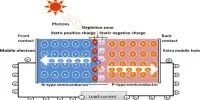The electrostatic effect of astriction between two surfaces subjected to an electrical field is known as electroadhesion. It is a phenomenon that occurs when two surfaces adhere to each other using electric charges. Paper retention on plotter surfaces, astrictive robotic prehension (electrostatic grippers), and other applications are possible. It is a type of adhesion that is based on the attractive forces of opposite charges. Clamping pressures of 0.5 to 1.5 N/cm2 (0.8 to 2.3 psi) have been reported.
One surface is typically coated or embedded with an electrode or conductive material in electroadhesion, while the other surface is typically dielectric or non-conductive. When an electric field is applied between the two surfaces, opposite charges on each surface are induced, resulting in an attractive force between them.
An electroadhesive pad is made up of conductive electrodes that are adhered to a polymer substrate. When alternate positive and negative charges are induced on adjacent electrodes, the resulting electric field creates opposite charges on the surface that the pad touches, resulting in electrostatic adhesion between the electrodes and the induced charges in the surface material.
Similar to how static electricity can cause objects to cling together, this attractive force allows the surfaces to stick together. However, because the electric field can be manipulated to vary the strength of the adhesion, electroadhesion is typically a more controlled and adjustable method of adhesion.
In practice, rheology is primarily concerned with using elasticity and (Newtonian) fluid mechanics to characterize the flow of materials that exhibit a combination of elastic, viscous, and plastic behavior. It is also concerned with predicting mechanical behavior (on the continuum mechanical scale) based on the material’s micro- or nanostructure, such as polymer molecular size and architecture in solution or particle size distribution in a solid suspension.
Application
Electroadhesion has a wide range of applications, including robotics, material handling, and adhesion technology. It can, for example, be used in robotics to create gripping systems that can pick up and manipulate objects without physical contact, allowing for more delicate handling and lowering the risk of damage.
Electroadhesion can also be used for temporary adhesion or clamping applications, where surfaces must be quickly and easily attached and detached. The adhesion can be turned on or off by controlling the electric field, resulting in a reversible and versatile adhesion method. Overall, electroadhesion is a promising technology that provides distinct benefits in terms of adjustable adhesion, non-contact handling, and temporary attachment in a variety of industrial and robotic applications.
















